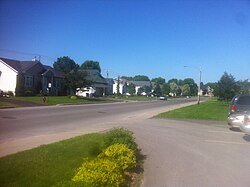Saint-Charles-Borromée, Quebec
| Saint-Charles-Borromée | |
|---|---|
| Municipality | |
 |
|
 Location within Joliette RCM. |
|
| Location in central Quebec. | |
| Coordinates: 46°03′N 73°28′W / 46.050°N 73.467°WCoordinates: 46°03′N 73°28′W / 46.050°N 73.467°W | |
| Country |
|
| Province |
|
| Region | Lanaudière |
| RCM | Joliette |
| Settled | 1855 |
| Constituted | July 1, 1855 |
| Named for | Charles Borromeo |
| Government | |
| • Mayor | André Hénault |
| • Federal riding | Joliette |
| • Prov. riding | Joliette |
| Area | |
| • Total | 18.70 km2 (7.22 sq mi) |
| • Land | 18.63 km2 (7.19 sq mi) |
| Population (2011) | |
| • Total | 13,321 |
| • Density | 715.0/km2 (1,852/sq mi) |
| • Pop 2006-2011 |
|
| • Dwellings | 6,123 |
| Demonym(s) | Charlois, Charloise |
| Time zone | EST (UTC−5) |
| • Summer (DST) | EDT (UTC−4) |
| Postal code(s) | J6E |
| Area code | 450 and 579 |
| Highways |
|
| Website | www |
Saint-Charles-Borromée, Quebec (2011 Population 13,321) is a municipality in southwest-central Quebec, Canada on the Rivière l'Assomption. It is in Joliette Regional County Municipality. It is home to the heritage house "Maison Antoine-Lacombe", which holds many expositions through the year. It is also home to the "Centre Saint-Jean-Bosco" which annually hosts the "Mémoires et Racines" festival for folk music from various countries and from Quebec.
The town takes its name from its original Roman Catholic parish, Saint-Charles-Borromée (canonically established in 1683). The parish's name, in turn, derives from the French name of an Italian Roman Catholic prelate, Charles Borromeo (1538–1584), the archbishop of Milan, who founded Roman Catholic order of the Oblates, and became a canonised saint, in the Roman Catholic calendar.
In 1832, Barthelemy Joliette built a sawmill and a flour mill on the banks of the l'Assomption river. He was soon followed by pioneers from Saint-Ambroise-de Kildare, Saint-Paul, and Sainte-Melanie, who began to clear the area. There has, since 1840, the founding of the parish of Saint-Charles-Borromee, whose canonical occurred in 1843.
Two years later, it's the foundation of Saint-Charles-Borromee-du-Village-d'Industrie, parish municipality at the origin of Joliette which decided to separate itself from the rest of the town in 1864 and was firstly named L'Industrie. It will cease to exist in 1847 and is territory became part of the Berthier county. The parish municipality of Saint-Charles-Borromee will be created in 1855. In 1864 when Joliette was erected, Saint-Charles-Borromee was amputated of an important part of his town but still covered a large area.
In 1870 the parish of Saint-Alphonse-de-Liguori took a small part of the western part of the town. In 1915, Joliette decided to explain is territory within Saint-Charles-Borromee at north and at the south. In 1956 The eastern part of the l'Assomption river decided to separate itself from Saint-Charles-Borromee and became Nortre-Dame-des-Prairies and in 1957, The southern part of Saint-Charles-Borromee decided to also separate itself and became the parish municipality of Saint-Charles-Borromée-Sud, which later merged with Joliette and became known with the name of "Quartier Base-de-Roc" and "Carrefour du Vieux-Moulin". This section also included the present location of the "Galleries Joliette". Finally the last part of Saint-Charles-Borromée, commonly known as "La Cité de Joliette" merge with Joliette in 1963.
...
Wikipedia

